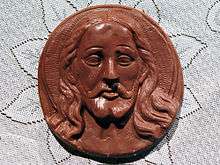Chocolate Jesus
Chocolate Jesus is the common name of a chocolate sculpture by Richard Manderson in 1994 who called it Trans-substantiation 2, by George Heslop in 2006 who called his work Jesus on the Cross and a third one by Cosimo Cavallaro in 2007 he called My Sweet Lord.

- For song by Tom Waits, see the Tom Waits' album Mule Variations
1994: Richard Manderson's works
Richard Manderson first created a series of small raspberry fondant filled chocolate Jesuses that were sold for consumption to visitors of Gorman House Arts Centre in Canberra, an Australian cultural centre and heritage site that runs theatres, workshops, exhibition space, artists' studios, offices and a café.
When a US newspaper condemned his act of depicting Jesus on a chocolate, Manderson decided in answer to create an actual life-size chocolate Jesus he called Trans-substantiation 2. He did so by filling a plaster mold with fifty-five pounds of melted chocolate. He used chocolate-dipped strings for hair and plastic Easter wrap for a loincloth. Manderson's work was exhibited in public around Easter in 1994, with Manderson inviting the public to come and eat his chocolate Jesus work after the exhibition.
Manderson explained that he felt that what had originated as a solemn holiday in contemplation of the resurrection of Christ had become a "rather ugly period of over consumption".
2006: George Heslop's work
George Heslop, an English artist created the Jesus Crucifixion scene made of chocolate. His work was displayed in April 2006 in Bradford-on-Avon in Wiltshire as part of Ale and Porter gallery’s Chocolate exhibition. Chocolate reproductions also included a depiction of Michelangelo's David and Dalí's Venus, in addition to a chocolate tree, chairs, townscapes etc. He said he wanted to draw attention to the practice of "retail opportunism" that takes place during Easter.
2007: Cosimo Cavallaro's work
Cosimo Cavallaro's created an initial chocolate Jesus. But the work was damaged by rodents incidental to its storage in Brooklyn. Subsequently, he recreated in 2007 a work called My Sweet Lord for a Holy Week display at the Lab Gallery at the Roger Smith Hotel in Manhattan. His sculpture displayed an 'anatomically correct' Jesus with full frontal nudity in a crucifixion position, and with no artistic loincloth covering Jesus' private parts.[1]
The planned exhibition resulted in many protests. In a famous confrontation between the artist and Bill Donahue, the president of the Catholic League commenting during a CNN show hosted by Anderson Cooper that Cavallaro's work was "one of the worst assaults on Christian sensibilities ever".[2][3] The Catholic League also called it "hate speech". After Cacallaro received many objections and threats, and the Catholic League asked for boycotting the Roger Smith Hotel, Cavallaro decided to call off the controversial exhibition.[4]
In media and the arts
- In 1997, author Stephen Jaramillo, published his fiction book Chocolate Jesus on Berkley Books. The plot revolves around Sydney Corbet, selling his idea for a chocolate Jesus to a candy company to pay off a gambling debt, but then is forced to reckon with stiff opposition and a crusade against the candy company.
- In 1999, Tom Waits recorded the song "Chocolate Jesus" that appeared on his album Mule Variations. It was co-written by Tom Waits and Kathleen Brennan. The song has been covered by a number of other recording artists.
- In 2010, Thomas Quinn described his encounter with a chocolate Jesus that led him to a spiritual questioning of Christian beliefs in What Do You Do with a Chocolate Jesus? An Irreverent History of Christianity published by BookSurge.
Notes
References
- Nathalie Gheit, Esquire magazine: The 485,460-Calorie Messiah - The six-foot tall, milk-chocolate Jesus Christ art catastrophe. (March 28, 2007)
- NBC News / Associated Press: 'Chocolate Jesus' exhibit canceled after uproar (30 March 2007)
- FoxNews: Display of Controversial 'Chocolate Jesus' Sculpture Cancelled
- CBC News: Chocolate Jesus under wraps for now (April 2, 2007)